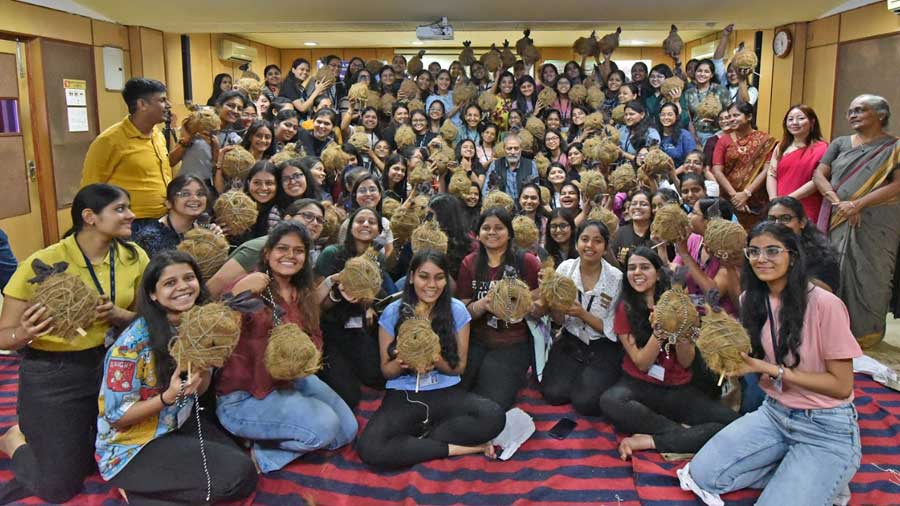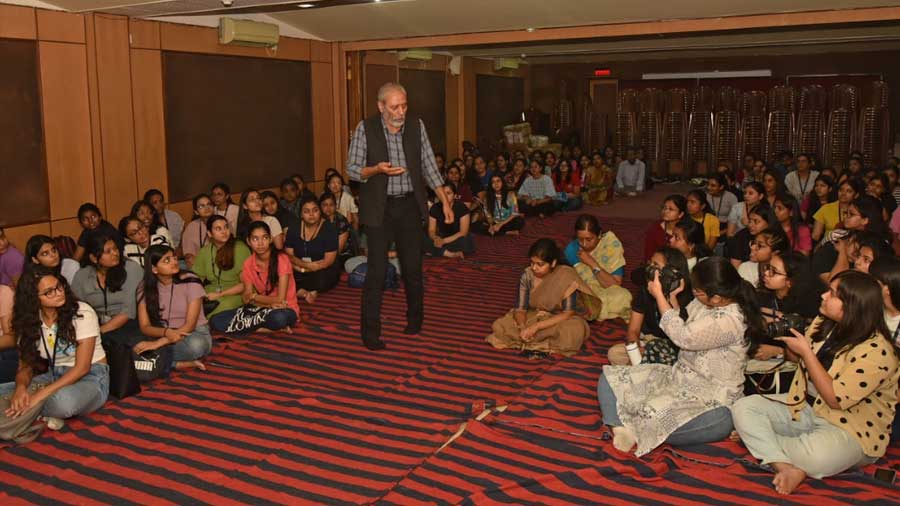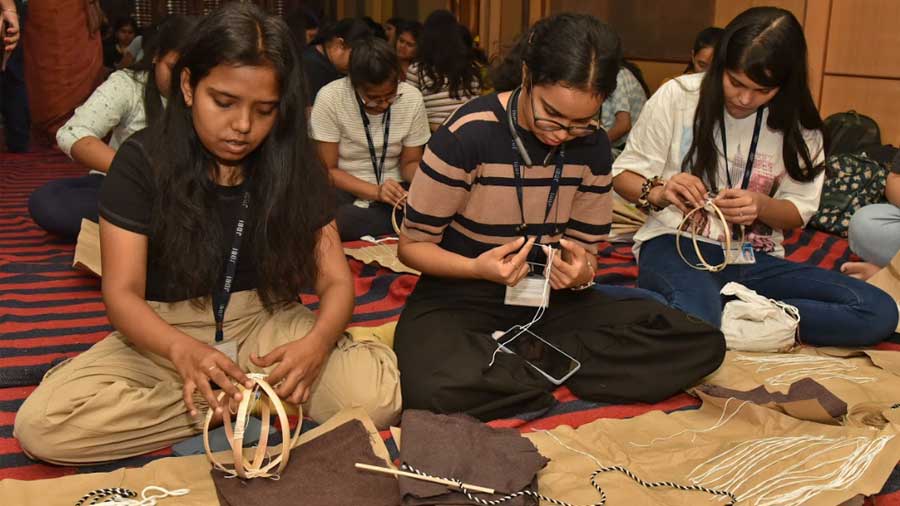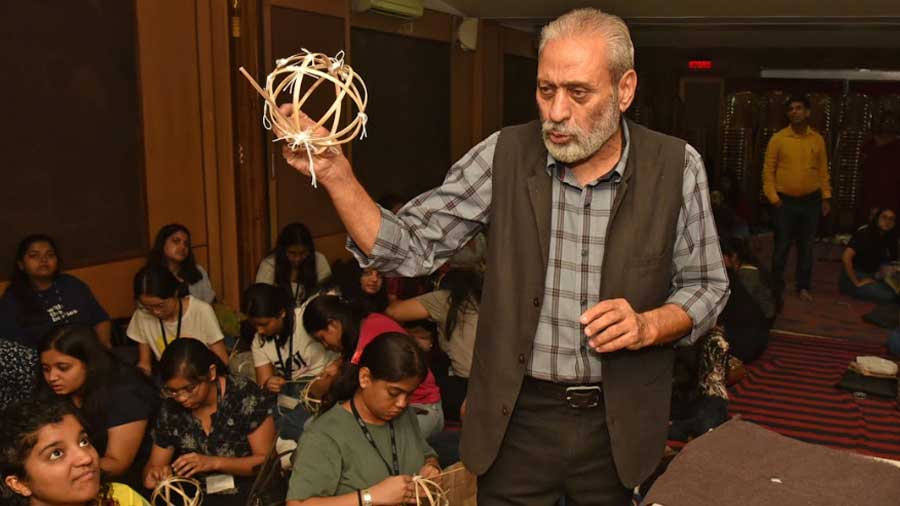A boy who woke up to the chirping of birds in a bustling neighbourhood of old Delhi started missing the feathered friends as he grew older and his city slowly turned into a concrete jungle. That’s when Rakesh Khatri decided to give the birds homes, quite literally building them by hand, and earning the title of Nest Man.
Khatri, who has been building nests since 2008, picked up his tools to teach young green activists how to make nests for birds at a workshop conducted by the NSS wing of JD Birla Institute, Kolkata. More than 400 students attended the three sessions.

For the first session, about 150 students joined the workshop from commerce department
Rakesh Khatri began his journey of conserving birds by building nests for them in 2008 after he noticed that house sparrows were slowly disappearing.
“I spent my childhood in a bustling neighbourhood of Old Delhi where we woke up to the chirping of birds. I would feed these birds, sometimes catch them and free them again. But after the late-1990s the sparrows slowly started disappearing because the city became a concrete jungle with no place left for them to build nests. That is when I started building homes for them with my family's support and after much trial and error we succeeded," said the founder of Eco Roots Foundation, an organisation that spreads awareness about bird conservation and Nest building.

Khatri explained every step while the students followed closely
Khatri has so far made over 6 lakh successful nests from coconut shells and recycled tetra packs. He mostly uses recyclable and eco-friendly materials to make these nests. At the workshop, he displayed a birdhouse made of compressed tetra packs. He claimed that almost 300 tetra packs were used to make it.
Khatri started the first session of the workshop with about 150 students from the commerce department. After a general introduction on bird conservation, building nests and its importance, the eager students were handed out a kit each. Each kit consisted of strings, ropes, a piece of cloth, five bamboo rings, a small metal ring and some coconut fibre.

A bird house built by Khatri with compressed tetra packs
Khatri, assisted by his disciple and director of Eco Roots Foundation Nipun Kaushik, showed the students how to build a bird nest step by step with the given material.
Very carefully, the good Samaritan for birds put together five bamboo rings to make a globe-like structure secured tightly with strings and then created a small dock at the bottom. "This piece of bamboo sticking out is supposed to work like a dock for the birds because they can't fly directly into the hole. They land on this and jump inside," Khatri explained. A metal bangle was fixed to make a door-like entrance.

The conversationalist securing the nest with coconut fibre and string
Then he took the piece of cloth and covered the globe, tying a knot on the top. He made a small cut on the cloth where a metal bangle was placed to make a small entrance for the birds. He said, "The entrance should not be very big since it might then be attacked by bigger predatory birds. Just leave it by making a small hole and the birds will widen it on their own." Then he put together the coconut fibre on the structure and wrapped them around with ropes. In about 25 minutes, a sturdy bird's nest was ready with every participant.
“It was so easy to make with his clear instructions. The workshop was not only fun but satisfying too,” said Mansi Jaria, a first-year student of BCom.

Mansi Jaria and Sanhita Ghosh posing with their handmade nests
Sanhita Ghosh, another student from first year BCom, joined the workshop for her love of animals and birds. “I have grown up around animals and birds. Every passing day, I seem to realise that we only take from nature and never think of giving back. So when I heard about this workshop, I immediately signed up. I will make more of these nests and put them around my house,” she said.
Followed by the first session, two other sessions were held for the students of science and management.

Students at work, nest under-construction
Speaking to My Kolkata, Khatri spoke about the importance of educating young minds through such workshops. “I mostly work with children and the youth because they are the future of this earth. I believe in engaging with the roots and for children it is very important to be rooted. It is essential for them to develop feelings of compassion. Many children nowadays won’t be able to name five common birds. Most of them might not have even seen five of them around. This is because we took away the homes of these birds and never cared to return them. Through such workshops and by building nests, we are giving them the lost homes. We need to do nothing after making the nests, the birds take possession from there,” he said.
Observing the students' eagerness and excitement, the principal of the college, Deepali Singhee, said, "We try to conduct such events at JD Birla Institute to make students aware about the importance of saving the environment. It is overwhelming to see so many students registering for the workshop."
The nests made by the students will be put on display at JD Birla Institute on Lower Rawdon Street near Minto Park on May 19 on the occasion of World Endangered Species Day.
